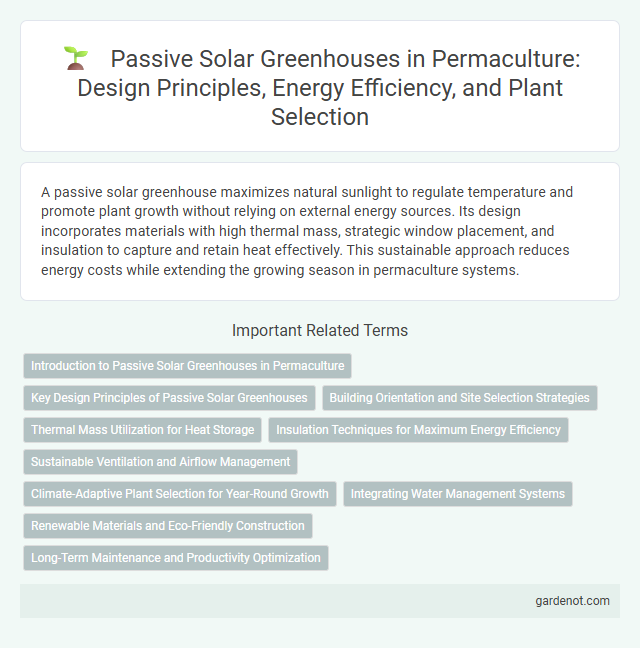A passive solar greenhouse maximizes natural sunlight to regulate temperature and promote plant growth without relying on external energy sources. Its design incorporates materials with high thermal mass, strategic window placement, and insulation to capture and retain heat effectively. This sustainable approach reduces energy costs while extending the growing season in permaculture systems.
Introduction to Passive Solar Greenhouses in Permaculture
Passive solar greenhouses in permaculture harness natural sunlight and thermal mass materials to create energy-efficient growing environments. By capturing solar energy during the day and releasing stored heat at night, these structures extend growing seasons and reduce reliance on artificial heating. Integrating passive solar design principles with permaculture practices enhances sustainable food production and ecosystem resilience.
Key Design Principles of Passive Solar Greenhouses
Passive solar greenhouses maximize natural sunlight through strategic orientation and use of thermal mass materials such as concrete or water barrels to store heat. Insulation techniques, including double glazing and airtight construction, reduce heat loss, while ventilation systems prevent overheating and maintain optimal humidity levels. Key design principles emphasize maximizing solar gain, minimizing heat loss, and ensuring effective temperature regulation to create a sustainable growing environment year-round.
Building Orientation and Site Selection Strategies
Optimal building orientation for a passive solar greenhouse maximizes sunlight exposure, ideally facing south in the northern hemisphere to capture the peak sun path during winter months. Site selection should prioritize locations with minimal shading from trees or structures, good soil drainage, and natural windbreaks to enhance thermal regulation. Incorporating these strategies improves energy efficiency, promotes plant growth, and supports sustainable permaculture practices.
Thermal Mass Utilization for Heat Storage
Passive solar greenhouses maximize thermal mass utilization by incorporating materials such as concrete, brick, or water barrels that absorb, store, and slowly release heat throughout the day and night. This method stabilizes internal temperatures, reducing the need for external heating sources and extending the growing season. Effective thermal mass placement on the greenhouse's interior south-facing walls or floors ensures optimal solar energy capture and heat retention.
Insulation Techniques for Maximum Energy Efficiency
Passive solar greenhouses utilize advanced insulation techniques such as double or triple-glazed windows, thermal mass materials like concrete or stone, and airtight sealing to maximize energy retention and reduce heat loss. Incorporating insulated foundation walls and thermal curtains further enhances the greenhouse's ability to maintain stable internal temperatures. These methods collectively optimize solar heat gain, minimizing reliance on external energy sources and promoting sustainable, year-round crop production.
Sustainable Ventilation and Airflow Management
Passive solar greenhouses utilize sustainable ventilation techniques to optimize airflow and maintain stable internal temperatures, reducing the need for mechanical climate control. Strategic placement of vents, such as roof vents and ground-level intakes, enables natural convection, promoting effective air circulation and preventing heat buildup or stagnation. Incorporating thermal mass materials, like stone or water barrels, further stabilizes temperature fluctuations by absorbing heat during the day and releasing it at night, enhancing energy efficiency and plant health in permaculture systems.
Climate-Adaptive Plant Selection for Year-Round Growth
Passive solar greenhouses maximize sunlight and thermal mass to create a stable internal climate, enabling year-round plant growth even in harsh environments. Selecting climate-adaptive plants such as cold-hardy greens, resilient perennials, and drought-tolerant herbs optimizes productivity while minimizing resource inputs. Integrating native species suited for local microclimates enhances biodiversity and promotes sustainable, low-maintenance growth cycles throughout all seasons.
Integrating Water Management Systems
Passive solar greenhouses maximize sunlight capture and thermal mass to regulate temperature naturally, reducing energy costs. Integrating water management systems such as rainwater harvesting, drip irrigation, and greywater recycling enhances sustainability by conserving resources and maintaining optimal humidity levels. These combined strategies improve plant health, increase yield, and promote efficient ecosystem management within permaculture designs.
Renewable Materials and Eco-Friendly Construction
Passive solar greenhouses utilize renewable materials such as reclaimed wood, bamboo, and recycled glass to reduce environmental impact and enhance sustainability. Eco-friendly construction methods prioritize insulation with natural fibers, non-toxic sealants, and energy-efficient glazing to optimize heat retention and minimize carbon footprint. Integrating rainwater harvesting systems and thermal mass elements further supports renewable resource use and sustainable plant growth year-round.
Long-Term Maintenance and Productivity Optimization
Passive solar greenhouse design maximizes energy efficiency by leveraging strategic orientation, thermal mass, and insulation to sustain optimal growing conditions year-round. Regular monitoring and adjustment of ventilation, shading, and moisture levels are essential for preventing plant stress and ensuring consistent productivity. Integrating permaculture principles such as polyculture planting and soil regeneration techniques enhances long-term soil health and resilience, boosting overall yields sustainably.
Passive solar greenhouse Infographic

 gardenot.com
gardenot.com